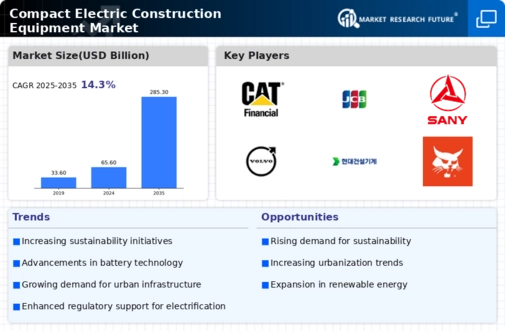Market Share
Compact Electric Construction Equipment Market Share Analysis
In the rapidly evolving landscape of the Compact Electric Construction Equipment Market, companies deploy various market share positioning strategies to establish a competitive edge and address the growing demand for sustainable construction solutions. A fundamental strategy centers around technological innovation. Companies invest heavily in research and development to create compact electric construction equipment with advanced features such as improved battery efficiency, reduced emissions, and enhanced performance. By staying at the forefront of technological advancements, brands position themselves as leaders in providing eco-friendly and efficient alternatives to traditional construction machinery, appealing to environmentally conscious contractors and construction companies.
Pricing strategies play a pivotal role in determining market share within the Compact Electric Construction Equipment Market. Some companies adopt a cost leadership approach, positioning their electric equipment as cost-effective over the long term due to lower fuel and maintenance costs. This strategy resonates with budget-conscious construction professionals looking to minimize operational expenses. Conversely, premium pricing strategies focus on positioning electric construction equipment as high-end, technologically advanced solutions. Brands that emphasize durability, smart features, and improved productivity target clients who prioritize performance and sustainability, even at a higher upfront cost.
Effective marketing is crucial to market share positioning within the Compact Electric Construction Equipment Market. Companies invest in comprehensive marketing campaigns to showcase the benefits of electric equipment, including reduced noise, lower emissions, and enhanced operator comfort. Engaging content through digital platforms, industry events, and partnerships with construction associations helps build brand visibility and credibility. Marketing efforts that highlight the long-term cost savings, regulatory compliance, and environmental stewardship associated with electric construction equipment contribute to influencing purchase decisions.
Optimizing distribution channels is integral to market share positioning. Establishing partnerships with construction equipment dealerships, rental companies, and online platforms ensures that electric construction equipment is readily available to contractors and construction firms. Additionally, collaborations with government agencies and sustainable construction initiatives contribute to increased visibility and accessibility, aligning brands with the broader industry shift towards greener practices.
Strategic collaborations and partnerships within the Compact Electric Construction Equipment Market are instrumental in market share positioning. Aligning with battery technology providers, charging infrastructure developers, and industry associations allows companies to leverage complementary expertise. Collaborations can lead to advancements in battery technology, expanded charging networks, and joint efforts in advocating for the adoption of electric construction equipment in construction projects.
Sustainability has emerged as a defining factor in market share positioning within the Compact Electric Construction Equipment Market. With heightened awareness of environmental impact, brands that prioritize electric solutions, highlight carbon footprint reductions, and implement eco-friendly manufacturing practices gain favor. Communicating these sustainability initiatives through certifications, labeling, and marketing campaigns not only attracts environmentally conscious contractors but also positions the brand as a key player in driving the industry towards a more sustainable future.
Consumer education plays a vital role in market share positioning within the Compact Electric Construction Equipment Market. Brands invest in informative content that educates construction professionals on the benefits of electric equipment, dispelling myths and addressing concerns related to battery life, charging infrastructure, and overall performance. By providing transparent information, companies empower potential buyers to make informed decisions, fostering trust and long-term brand loyalty.










Leave a Comment